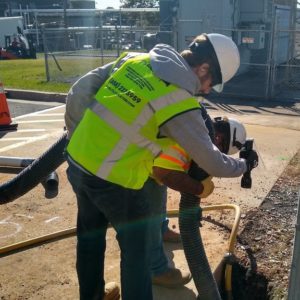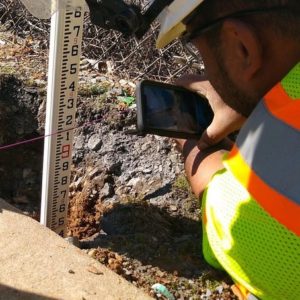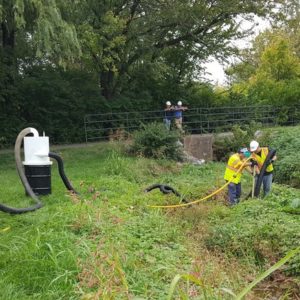Vacuum Excavation
YOU NEED UTILITY DATA, WE COLLECT UTILITY DATA
 You have a job to do, and we help you get it done right with our air vacuum excavation services. Also known as Soft Dig or Daylighting, vacuum excavation is the safest and most reliable method of obtaining cost effective subsurface utility data for engineering and construction phases of projects.
You have a job to do, and we help you get it done right with our air vacuum excavation services. Also known as Soft Dig or Daylighting, vacuum excavation is the safest and most reliable method of obtaining cost effective subsurface utility data for engineering and construction phases of projects.
Exposing a utility is the only safe and reliable method to collect “Quality Level A” data in accordance with CI/ASCE 38-02, which refers to the collection and depiction of subsurface utility data.
In addition to Quality Level A data, air vacuum excavation is the safest way to spot check existing underground utilities prior to any excavation activities. This technology may also be utilized to perform the excavation work itself in some instances.
THE DOCUMENTATION YOU NEED TO GET THE JOB DONE RIGHT
 We provide our clients with all of the documentation you’ll need for each underground utility test hole performed. We’ll include a report detailing critical utility information such as the utility size, material composition, surface depth, soil conditions, and more. We’ll also draft an overview map indicating the test hole locations, and a matrix spreadsheet containing all of the utility data in one easy to read document.
We provide our clients with all of the documentation you’ll need for each underground utility test hole performed. We’ll include a report detailing critical utility information such as the utility size, material composition, surface depth, soil conditions, and more. We’ll also draft an overview map indicating the test hole locations, and a matrix spreadsheet containing all of the utility data in one easy to read document.
Need more data? We can work with your current survey department or firm of choice to provide CI/ASCE 38-02 Quality Level A data in any format you need.
WE’LL DIG UTILITY TEST HOLES ANYWHERE YOU NEED THEM
 Using a remote excavation unit, Utility Locator® can perform utility test hole excavations up to 200 feet away from our vacuum excavation truck.
Using a remote excavation unit, Utility Locator® can perform utility test hole excavations up to 200 feet away from our vacuum excavation truck.
A remote drum can be connected to our vacuum excavation trucks using up to 200′ of suction hose and a special interceptor attachment. This allows Utility Locator® to excavate remotely where a standard vacuum excavation truck can’t go.
Spoils can easily be used to backfill test holes, or kept in the standard 55-Gallon drums for storage or removal from the site.
You’ve got questions, we’ve got answers
How does air vacuum excavation work?
Vacuum Excavation works by using a high pressure air stream to disturb the ground surface. A common utility test hole will range from 12 inches to 16 inches in diameter. A high powered vacuum is then used to collect the spoils, which are deposited into a high capacity storage tank.
The air pressure that is used to disrupt the ground is typically between 120psi and 300psi. Storage tanks can range from 75gal up to 500gal.
Test Holes are typically restored using the spoils that were removed from the location, however the spoils can also be stored on site using portable drums, or can be removed from the site entirely.
How quickly can you excavate a test hole using air?
In general, we have the capacity to excavate 5-10 test holes per day for each truck mobilized. This rate can be increased or decreased on a variety of factors including traffic, surface material, soil material, utility depth, and other working conditions.
Can you excavate through concrete or asphalt?
Yes! When performing a test hole or excavation with an air vacuum truck, a clean hole is first cut using a concrete/asphalt saw or core drilling machine. This allows for access to the utility below the surface and will also provide the conditions necessary for a clean and professional restoration.
How much notice do you need to mobilize a truck?
In general, we can mobilize our vac truck to perform test holes in about 3-5 days. Some of the circumstances that may effect our availability include:
- Call 811 – Even though air vacuum excavation is regarded as one of the safest methods to excavate and test pit a utility, we are still required by law to notify Call 811 prior to digging.
- Traffic Control – Should any test holes be located within an active right-of-way, we may need additional time to procure permits, design traffic control plans, and hire a qualified MOT/TTC firm.
- Permits – Permits may be required by local, county, or state governments to perform test holes at your project site. Should permitting be required, we may be delayed in responding to your request.
The depth of a utility test hole that is dug with air vacuum excavation depends on the type of soil that is being excavated and obstructions encountered while performing the test hole excavation. In general, most test holes can be excavated up to around 12 to 15 feet in depth.
Can you perform air vacuum excavation for soil borings?
Yes! We are able to excavate soil boring locations to confirm the absence of utilities. Spoils can be left at the site or backfilled immediately. Boring locations can be cleared of utilities to a depth of 10-15 feet if required.
What is CI/ASCE 38-02 Quality Level A data?
CI/ASCE 38-02 outlines four different quality levels for the depiction of subsurface utility data. Each quality level represents a different “reliability” for the utility information presented. The levels range from Quality Level D (least reliable) through Quality Level A (most reliable).
The quality level of utility data provided by vacuum excavation is considered the highest and most reliable. Quality Level A data is the most reliable form of utility data because it involves physically exposing an underground utility using vacuum excavation. Once exposed, critical utility data can be collected including precise horizontal location and exact utility elevation. QL-A data is most commonly acquired at critical conflict points for proposed installations of structures or utility systems.
